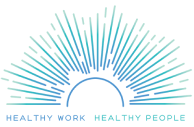Healthy work is essential to maintaining and developing healthy, productive and sustainable organizations. Healthy work is more than helping individual employees make healthier choices; it is work that is physically, psychologically and socially healthy.
We know from over 40 years of scientific research that sources of stress from the way work is organized contribute to increased risk of burnout and depression, as well as high blood pressure and heart disease. When workers experience work-related psychosocial stressors, such as excessive workloads, a lack of say or voice (job control), inadequate supervisor or coworker support, job insecurity, long work hours or many other stressors, they also report poorer physical and mental health, are less engaged, and are more likely to come to work sick with decreased work quality (presenteeism) or take sick leave (absenteeism). (See Principles of Healthy Work to learn more.)
Costs of Unhealthy Work to Organizations

Unhealthy work costs organizations more than just healthcare dollars. It also results in increased disability/workers compensation costs, sickness abscence, job turnover, and lost productive work-time when workers are present but not performing at full capacity, because of work stressors and related illness. These costs are estimated in the hundreds of billions.2 (See the Business Costs of Unhealthy Work to learn more.)
we need healthy work.
It makes smart business sense to ensure we all have healthy work—to foster productivity, save costs, and (most importantly) to save lives. Since most of us consider healthy and safe work to also be a human right, organizations need to pay attention to the impact of unhealthy work on the quality of life of our children, families, communities and nation.
The Healthy Work Campaign (HWC) is committed to sharing with your organization what we have learned about healthy and unhealthy work (and its costs), as well as to proposing solutions. To assist companies, we are developing a Healthy Work Survey (HWS) to assess the stressors at your workplace, as well as a toolkit of interventions designed to enhance work culture, reduce work stress and improve health and well-being.

We are asking organizations, large and small, to expand their concept of corporate social responsibility and TAKE PART in changing our work culture and the way work is organized in the U.S. With our resources and assessment tools, as well as your commitment to healthy work, together we can begin to make work healthier and more productive for all.
See our MISSION page to get the story behind our commitment to healthy work and the resources below to MAKE A DIFFERENCE to the health and well-being of your workers and your organization.
Is Your Organization Healthy?
See our Principles of Healthy Work & take the Healthy Work Survey to find out.
What Can Your Organization Do About Unhealthy Work?
Use our Healthy Work Tools & Get Feedback.
How Can Your Organization Do More?
Thanks!
1. Goh, Pfeffer and Zenios. “The Relationship Between Workplace Stressors and Mortality and Health Costs in the United States.” Management Science, 2015
2. Jauregui and Schnall. Work, Psychosocial Stressors and the Bottom Line. In: Unhealthy Work: Causes, Consequences, Cures. Baywood, 2009






